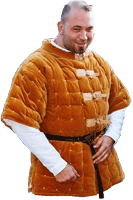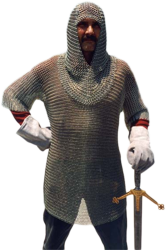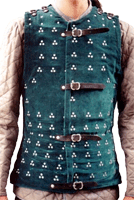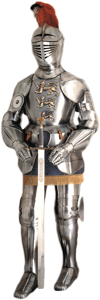Armour
The armour is based upon that commonly available in the early 15th Century.
Armour absorbs damage from successful strikes and deflects those non-perfect blows into glancing blows.
There are effectively four types of attack cut, thrust, chop and bludgeon (sword, spear, axe and hammer). Different weapons work best against different types of armour. Chain mail is almost proof against a slashing sword blow yet provides little protection against a mace, or other bludgeon weapon, similarly war arrows are designed to pierce chainmail splitting the rings. Plate was virtually impervious to swords, the attacker had to aim for the holes left in the armpits, knees and similar places; but hammers and maces transfer the shockwave to the internal organs pulverising them without touching them and the battle-axe spike backed by a heavy head pierces plate armour like butter. Axes unless struck perfectly were also likely to skid off.
These differences however are ignored for the sake of simplicity since damage is modelled as a reduction of stamina rather than as physical cuts and bruises.
See the Medieval Combat Guild for a good description of armour.
Note: there seems to be as many types of armour (and weapons) and ways of wearing it as there are answers to a typical google search. All I'm trying to do here is devise a system that works.
- Body armour reduces any damage.
- Helms & Breast Plates reduce damage to the vital areas.
- Shields help to parry a blow, preventing the body being hit. Bucklers only work with swords, they are used to protect the sword hand when it is extended.
Armour Type
|
Padded / Gamberson / Acheton |
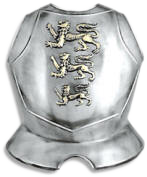
Metal breast plate Late 14C |
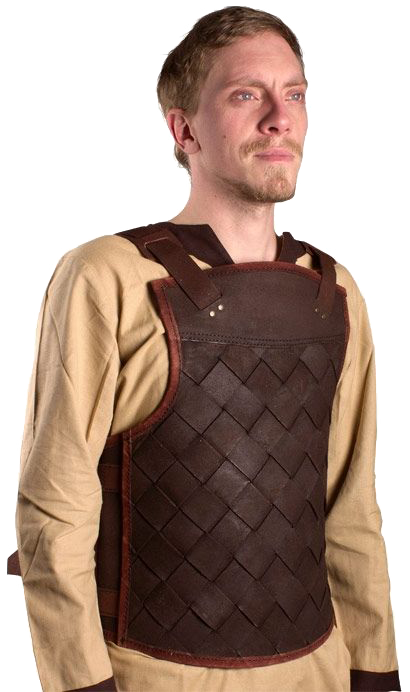
Leather |
Mail Hauberk |
||||||||||||||||||||||||||||||||||||||||||||||||||||||
|
Late 15C Briagandine |
|
16C |
|||||||||||||||||||||||||||||||||||||||||||||||||||||||
Metal armour squeaks, rattles and makes noise against your other equipment and cannot be made silent (bar a silence spell), that's why people (thieves) wear leather or padded.
† The athletics mod is also applied to all athletics checks requiring full body dexterity e.g. dodge, acrobatics and climbing. This excludes dodge as the defence modifier is applied directly instead. (This is a kludge but it's too late to change this now). It also limits the maximum Acrobatics skill level available.
^ The fighting style of bucklers means they are only used with one handed swords. They can be hung from the belt for quick access.
# Includes ranged spell attacks and (most) AoE spell effects originating from a point (e.g. fireball but not lightning bolt). The bonus assumes you have spotted the incoming and are trying to take cover behind the shield.
‡ Most races have a base 20' - 25' movement, armour hinders this.
* Effect is the reduction in average damage compared to the next best. This uses the actual damage taken when struck for 6-15 damage, i.e. it takes into account the order in which damage is absorbed. It does not take into account any difference in the chance to be hit.
Armour locations
If where a target is hit is ever of importance (such as critical injuries) then the folowing table is used.
| Location | Roll |
|---|---|
| Head | 10 |
| Arms | 9 |
| Shoulder | 8 |
| Chest | 6-7 |
| Abdomen | 4-5 |
| Thighs | 2-3 |
| Lower legs | 1 |
Armour effectiveness
Wearing armour helps you absorb damage, the amount absorbed depends upon the armour type. Any actual armour will affect your athletics ability. Damage is rounded in favour of the defender.
Physical Weapon damage
Damage factor |
Damage taken | Damage pattern |
|---|---|---|
| 1.5 | Plus 50% damage (round down) | X2 |
| 1.2 | Take 1,1,1,1,2 | XXXX2 |
| 1 | Normal damage | X X X X |
| 3/4 | Miss 1 take 3 | -XXX-XXX |
| 2/3 | Miss 1 take 2 | -XX-XX-XX |
| 1/2 | Miss 1 take 1 | - X - X - X |
| 1/3 | Miss 2 take 1 | - - X - - X - - X |
Thus plate only takes half of the damage so the character only suffers the second point taken.
Against magic
Armour provides no bonus against magic (except elemental magic which is counted as the elements) or is of a specific type (e.g. bludgeon).
Against the elements
Different types of main body armour are effective against different elements. This is only against direct area blast effects. The padding under metal armour is too thin to have a noticeable benefit.
| Save | Protects against | |
|---|---|---|
| Padded | +1 | Cold |
Body armour
Most towns do not permit the wearing of armour except padded (including shields) within the walls unless you are noble, have been given the freedom of the town or are part of the guard. It must be packed up before entering the gates.
Armour descriptions
Leather
Leather is not really armour at all and not something that any self respecting fighter would wear. Although reasonably against cutting damage if thick it does nothing against crushing blows and little against piercing weapons. Leather can be considered to be any atypical heavy clothing as stylistically desired or possibly slightly better armour but only covering a limited portion of the body.
Padded / furs
Padded is constructed of an multiple linen layers (up to 30), stitched together with either horizontal, vertical, checked or diamond patterning. The barbarian/monster equivalent of padded is furs. They have the same characteristics. It is suprisingly good against cutting and piercing weapons and even good against crushing but it does tend to need repair more frequently than mail.
Silk armour is a light type of padded that stops you getting too hot in deserts or other hot climes. It doesn't help protect against cold attacks.
This is a combination of solid and rivited rings either worn as a hauberk covering the torso, upper legs and upper arms or as a full suit. Mechanically it makes no difference, it is a style choice. Although relatively heavy it is flexible allowing and the weight is well distributed (shoulders, arms and waist through the belt ) causing a minimal restriction to movement. It is designed to deflect the glancing blows of swords and is an excellent defence against cutting weapons, good against non specialised piercing weapons but not so good against bludgeon where the underlying light gamberson has to take most of the force.
Often worn with a surcoat to protect it from the weather.
Brigandine / Coat of plates
A coat of plates comprises several large plates sewn or riveted into a cloak, sometimes with a leather outer (so looks like the non-existent studded leather). A coat of plates is strapped at the back so requries help to put on. Brigandine is similar but has many smaller plates and attaches at the front so can easily be put on by the wearer (even if it does take a a minute to strap up).
Both are worn over mail which is worn over a light gamberson. They are almost as good as plate but only cover the chest and midriff area.
A coat of plates was available during the late 14th century and brigandine not until the late 15th. there was of course a half way house with large plates split at the front. For the purpose of the campaign it is assumed these are available so that heroes can put on their own armour (and remove it if they have to quickly).
Plate armour
This is a made to measure suit of armour plates providing good protection to much of the body.
It is not the fully enclosed plate of the Renaissance period which left no gaps but instead a series of pieces held on by leather straps with gaps on the backs of the thighes, knees, armpits, elbows and other places. Typically the characters left half of the armour would be stronger or cover more that the right as this side was proffered to the opponent and therefore more likely to be struck.
Each piece is individually attached over mail by leather straps some of which attach at the back. It requires 20 minutes to don unless you have a squire to help you which halves the time to 10 minutes. You cannot sleep in plate armour and recover stamina.
Plate armour always comes with a great helm or bascinet with visor. These both cause problems with perception and other skills.
Helms
Helms are worn to protect the vulnerable head area. With the covering of the head the perception of the person wearing the helm is reduced. Helms would normally be worn with an aventail (mail) to protect the neck.
Three basic types of helm are available
- Small helm / cervelliere
- Open faced bascinet
- Great helm or bascinet with visor
Not available yet.
- Great bascinet (bascinet with solid neck guard)
- Armet (bascinet with opening cheek flaps)
- Sallet (no visor, swept back neck protection)
Great helm
Under a great helm the person would wear a hidden helm (small or open faced bascinet). The great helm could them be taken off and slung over their back using attached chains whict stiull affording reasonable protection yet quick access to the helm.
For gameplay purposes a great helm is treated the same as a bascinet with visor.
Great helms and bascinets with the visor down mean the character's perception skills are all at disadvantage. They also cause the wearer to exhaust more quickly as there is reduced air flow.

Small Helm |
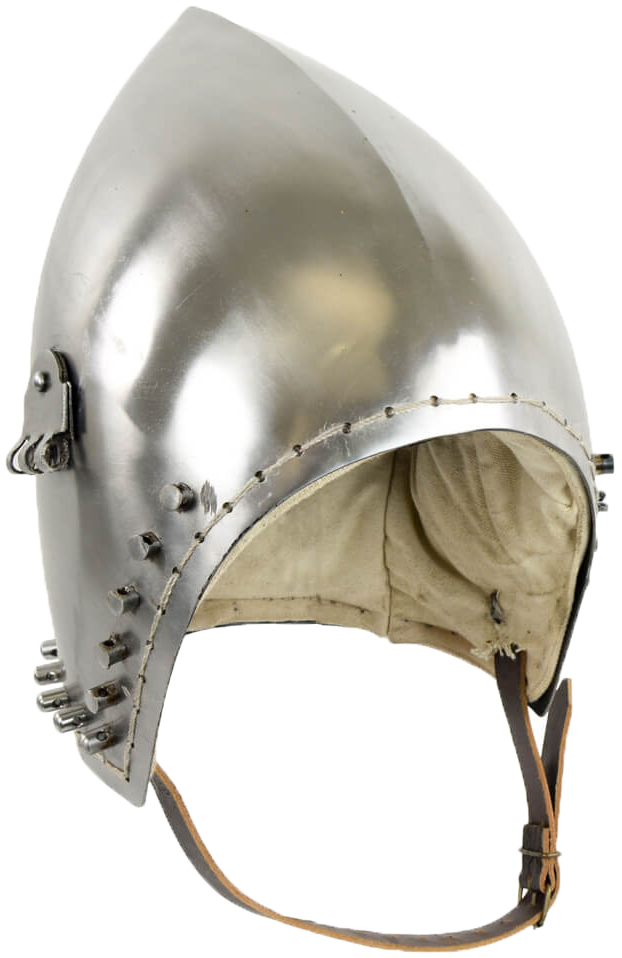 Open faced bascinet |
 Houndskull Bascinet |
 Great Helm |
Creatures and characters struck on the head or other vital location (e.g. by a feat) that suffer damage must make a Stun (endurance) save. The maximum effect is limited by the amount and type of damage.
Althgough helms provide better armour reduction than normal most only cover part of the face so the effect is averaged out as normal protection. There is no "Roll to see if you hit the helm".
Archers and similar ranged specialists will not wear anything bigger than an open faced bascinet as they restrict their vision too much.
In reality the larger the helm the lower your alertness and greater resistance to head shots and stuns but for the purpose of gaming simplicity the choice is only about style.
Stunning
When struck with a weighty object about the head creatures may be stunned. Stunning may also occur from magical effects or feats; regardless of the cause a stun check is required, END (12). Each success level reduces the effect by one place.
Depending upon the attack type the maximum effect may be limited, thus a cutting sword can never cause more than a 'Dazed' result and the saving throw (12) is related to that effect. The damage is teh damage suffered after absorbtion.
The effect lasts until the end of the round (or next if any action has already been taken).
| Attack Type | Min damage after absorb | Effect | Notes | Save Endurance |
|---|---|---|---|---|
| Bludgeon | 10 | Knock down | No actions | |
| Chop | 6 | Stunned | Minor action only | 12 |
| Any | 4 | Dazed | Init 10, disadvantage, 1/2 movement | 14 |
| Any | 2 | Frozen | No feats, Initiative disadvantage | 17 |
Some magic will only cause a Dazed or Frozen result. In these cases the saving throws relate to that effect.
A creature may never suffer a worse effect than the base, e.g. a Colour Spray spell that causes DAZED may (almost) never cause STUNNED regardless of the saving throw; the exception is if the save is fumbled in which case it gets one place worse.
Shields
Shields make it harder to hit somebody.
Although shields provide coverage they can be large, bulky and unwieldy which makes it harder to do other tasks, medium and bigger shields limit a character's dexterity whilst large ones are really only usable with a spear.
Shields become less effective the better armour you wear as they don't provide much additional benefit over the armour.
Shield types
The Buckler
The arming sword and buckler was the most common combination for much of the middle ages in open battle as the speed and agility it gave outweighed the advantages of the greater coverage and weight of a medium shield.
| The buckler was a small round, often metal shield which
could be hung from a belt. This type of shield was reserved for hand-to-hand
combat. The shields normally measured between 8 and 13 inches in diameter. They were held in a fist grip rather than strapped on like shields Many bucklers were pointed with a central tip or several smaller “teeth”. These points could be used offensively to great effect as well as aided in binding and deflecting an opponent’s weapon. |
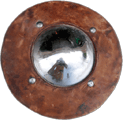  |
Medium shields
Both kite and heater style shields were made of several layers of laminated wood, with a gentle curve in cross section.
| Type | Description | 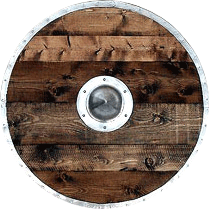 
|
|---|---|---|
| Kite | Rounded at the top of the shield and tapered at the bottom providing body cover. | |
| Heater | Strongly associated with jousting knights. These are smaller as they compliment full suits of armor and are suited to horseback | |
| Targe | The traditional Scottish / Viking round shield |
Large Shields
Large shields are unwieldy and can only be used with spears, or other stabbing weapons such as short swords. They are not suitable for use with arming swords, axes, maces... really anything other than spears. They are not used during the time period of the setting except as stationery pavaises.
| Type | Description |  |
|---|---|---|
| Scutum | The Roman Scutum served the purpose to deflect missiles targeted at the soldiers, as well as protect them from the impact of hand held weapons wielded at them. The shields large size allowed the soldiers to form a shield wall that could protect them during an advance. | |
| Pavise | The Pavise was the shield used by Crossbow men. This type of tall shield provided protection when reloading his crossbow |
Shield construction
Shield construction started with the type of materials that would be required for a particular type of shield. These were chosen according to the style of combat and armor worn by the owner to determine the weight and style of the shields. Medieval shield construction used the following materials:
- Wood
- Animal hides
- Metal
A Medieval shield construction might also include a strap called a guige that allowed it to be slung over the knight's back when not in use or on horseback
